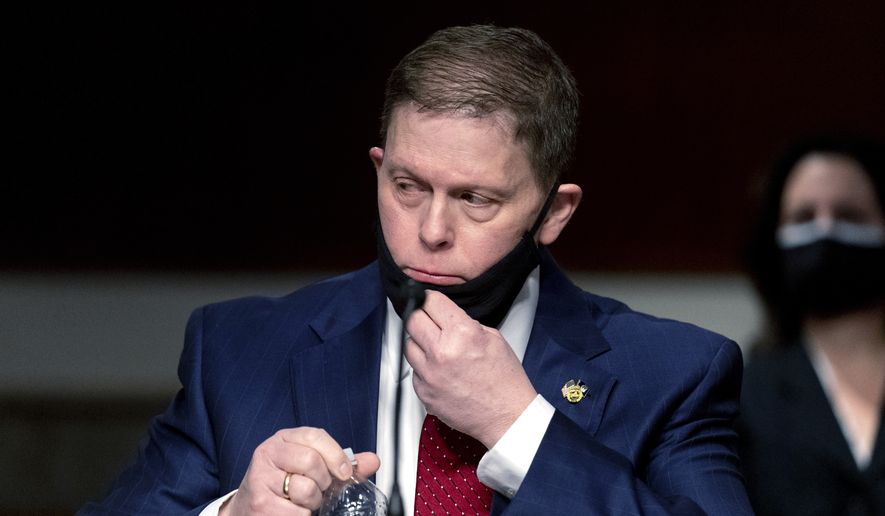Former U.S. Capitol security officials, who lost their jobs because of the security breakdown at the Jan. 6 riot, on Tuesday blamed poor intelligence sharing and lack of federal backup for what they described as a “coordinated attack” on Congress.
At the first congressional hearing on the security failure, former officials pointed their fingers at intelligence agencies.
Despite online chatter and media reports warning that pro-Trump agitators were targeting Congress ahead of the certification of the Electoral College vote, intelligence bulletins issued by the FBI, Secret Service and Department of Homeland Security did not elevate the threat levels.
“A clear lack of accurate and complete intelligence across several federal agencies contributed to this event and not poor planning by the U.S. Capitol Police,” former Capitol Police Chief Steven Sund told lawmakers.
Mr. Sund, who resigned in the wake of the attack, said the inaccurate threat assessments left the police significantly outnumbered as they tried to defend the building against a violent mob.
Police clashed with thousands of protesters outside the Capitol before hundreds breached the police line and broke into the building. The melee, televised live, shocked the nation and terrified lawmakers, who were whisked away to escape the mob.
SEE ALSO: Thomas Webster, retired NYPD officer, charged in Capitol riot
All four witnesses at the hearing said they saw evidence of “significant coordination” among rioters to carry out the attack.
“These people came specifically with equipment. You’re bringing climbing gear to a demonstration, explosives, chemical spray — you’re coming prepared,” Mr. Sund testified. “The fact that the group attacked our West Front 20 minutes before the event at the Ellipse ended — they were planning on our agency not being at full strength at that time.”
Mr. Sund was referring to a speech at the Ellipse near the White House, where President Donald Trump urged supporters to protest the election results.
The former chief said the placement of two pipe bombs in front of the respective headquarters of the Democratic and Republican national committees was an attempt to draw resources away from the Capitol.
Acting Chief Robert J. Contee III of the Metropolitan Police Department agreed that the attack was planned.
“I think there were hand signals that were being used by several of the insurrectionists,” Chief Contee said. “There were radio communication by several individuals that were involved. I certainly believe it was coordinated.”
Their assessment contradicted the Democratic lawmakers’ narrative that Mr. Trump incited the riot with his speech. However, the planning does fit their assertion that the impetus for the attack was Mr. Trump’s oft-repeated claim that the election had been stolen.
The security force at the Capitol was mostly caught off guard.
Paul D. Irving, a former sergeant-at-arms for the House of Representatives, said federal agencies missed the mark. They sent him memos that compared the protests planned for Jan. 6 to a relatively peaceful pro-Trump rally in November.
“The intelligence was not that there would be a coordinated assault on the Capitol, nor was that contemplated in any of the interagency discussions that I attended before the attack,” Mr. Irving said. “We all believed the plan met the threat, and we were prepared.”
Some of the intelligence compiled by the agencies didn’t reach key officials.
Mr. Sund said an FBI report issued the day before the attack and warning of violence at the Capitol never made it to him.
The FBI’s Norfolk office issued the warning, which outlined detailed calls for violence on Jan. 6, including protesters’ plans for a “war” at the Capitol.
Senate Homeland Security and Governmental Affairs Committee Chairman Gary C. Peters, Michigan Democrat, asked how he could not have received “vital intelligence.”
Chief Contee said he hadn’t seen the memo either, though he learned of its existence after the fact via an email. If the FBI had reliable intelligence that a violent insurrection at the Capitol was possible, he said, this “would warrant a phone call or something.”
Mr. Irving and Senate Sergeant-at-Arms Michael C. Stenger, who also testified at the hearing, also said they did not see the FBI memo.
Mr. Stenger said the assessments were the reason the National Guard was not activated ahead of Jan. 6.
“We all agreed the intelligence did not support the troops and collectively decided to let it go,” said Mr. Stenger, adding that a “robust” plan to protect lawmakers was in place.
Chief Contee said he and Mr. Sund pleaded with the Army to mobilize the National Guard after the mob stormed the building, but the Army was “reluctant” to deploy troops to the Capitol.
Mr. Sund said Army officials were worried about the optics of having National Guard troops in front of the Capitol even as the riot was unfolding and asked him to pull Capitol Police officers from other posts to make arrests.
Mr. Sund said he spoke with both sergeants-at-arms about requesting the National Guard two days before the riot, but Mr. Irving, the House’s chief security officer, raised the issue of “optics.”
Mr. Irving called that account “categorically false.” He said the threat assessments simply didn’t justify mobilizing the National Guard and that appearances didn’t matter.
On the day of the attack, roughly an hour passed before the Pentagon approved the request for more Guard troops to disperse the violent mob. Those troops arrived at 5:40 p.m., more than four hours after the initial request, Mr. Sund said.
Roughly 300 unarmed members of the D.C. National Guard were deployed that day, but only to provide traffic control and other services.
Mr. Contee said he was “surprised” and “stunned” by the Pentagon’s sluggish response.
• Jeff Mordock can be reached at jmordock@washingtontimes.com.




Please read our comment policy before commenting.